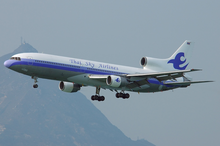Lockheed L-1011 TriStar
The aircraft has an autoland capability, an automated descent control system, and available lower deck galley and lounge facilities.The L-1011 TriStar's sales were hampered by two years of delays due to developmental and financial problems at Rolls-Royce, the sole manufacturer of the aircraft's engines.Having experienced difficulties with some of its military programs, Lockheed was eager to re-enter the civilian market with a smaller wide-body jet, and its response was the L-1011 TriStar.The TriStar was originally conceived as a "jumbo twin", but a three-engine design was ultimately chosen to give the aircraft enough thrust to take off from existing runways.[7] Also, before the establishment of Extended Operations standards by the FAA in the 1980s, commercial jets with only two engines were not allowed to fly more than 30 minutes away from an airport, making trans-oceanic flights impossible.[citation needed] Although the TriStar's design schedule closely followed that of its competitor, McDonnell Douglas beat Lockheed to market by a year due to delays in powerplant development.To rectify this problem and to meet performance guarantees, Lockheed developed a structural kit that allowed maximum takeoff weight (MTOW) to be increased on production aircraft from 409,000 to 430,000 pounds (186,000 to 195,000 kg).Costs at Rolls-Royce were controlled and its efforts largely went into the original TriStar engines, which needed considerable modifications between the L-1011's first flight and service entry.[2] The TriStar's rivalry with the DC-10 has been seen as a "case study in what can happen when two manufacturers attempt to split a market that simply could not support both aircraft".McDonnell Douglas was also financially weakened and could only develop the MD-11, a refinement of the DC-10, instead of an all-new design to challenge the next generation of twinjets like the Boeing 777.Further improvements led to a 15-degree afterbody, enabling the L-1011 "to beat its predicted specific air range at 0.85 Mach by between 3.5 and 5.5 percent, the exact figure depending on cruise weight.Lockheed's main drive away from a THS was "[eliminating] mis-trim and runaway trim problems that have contributed to a number of accidents in the past.Of those are a Mach/IAS cruise control, an automatic Rough Air Mode that detects turbulence and adjusts the engine power setting accordingly, and a descent mode that figures out the optimum location to start a descent by "back computing" from a preselected point, allowing "on-altitude and on-speed" arrival.[35][36] DLC helps maintain the aircraft on the glideslope during final approach by automatically deploying spoiler panels on the wings.The APU, which was the Pratt and Whitney ST6L,[37] was capable of operating up to 30,000 feet; its two square-shaped inlet doors are situated on the bottom fuselage on the aircraft's centerline towards the rear of the plane.TWA heralded the TriStar as one of the safest aircraft in the world in promotional literature in the 1980s when concern over the safety record of the McDonnell Douglas DC-10, flown by rival airlines, was at its peak.[40][41] The discovered scale to what has become known as the Lockheed bribery scandal led to the arrest of Japanese Prime Minister Kakuei Tanaka, as well as several other officials.[43] Tanaka was eventually tried and found guilty of violating foreign exchange control laws but was not charged with bribery, a more serious criminal offense.[49][50] The talks collapsed as US President Jimmy Carter made human rights an important consideration in US foreign policy.[51][52] The TriStar was also listed by the Coordinating Committee as embodying advanced technology forbidden for sale to potential enemies, which presented a serious obstacle to the export deal.ATA Airlines (formerly known as American Trans Air) fleet included over 19 TriStars, but operations dwindled to only three L-1011-500s before the company's shutdown in April 2008.The TriStar was replaced in RAF service by the Airbus A330 MRTT under the Future Strategic Tanker Aircraft program.The two L-1011 aircraft delivered to Pacific Southwest Airlines were configured with internal airstair doors that led into an entry hall in what was normally the forward lower baggage hold.This type was purchased by Air Canada, ANA, Cathay Pacific, Eastern, and other operators with regional trunk routes requiring a widebody aircraft.[23] The L-1011-100 (FAA certification L-1011-385-1-14) was the second production model of the L-1011 and first flew in 1975 and featured a new center fuel tank and higher gross weights that increased the aircraft's range by nearly 930 miles (1,500 km).The variant was also purchased by several airlines with longer-range routes, such as TWA, Air Canada, and BEA (which merged with BOAC to form British Airways).[citation needed] More powerful RB.211-524 engines, increased wingspan, active-load-control ailerons and other improved systems were features introduced by Lockheed to exploit newly available technologies in the late 1970s.The ACS developed to solve this, provided gust alleviation, improving ride during flight, reduced fuel burn, and increased fatigue life.Standard fuel capacity is 31,600 US gallons (120,000 L), giving the TriStar 500 a range of about 5,200 nautical miles (9,600 km) with 246 passengers and baggage.[70] Of the four pioneering widebody aircraft (Boeing 747, McDonnell Douglas DC-10, L-1011, and Airbus A300/A310 family), the Lockheed L-1011 had comparatively few accidents and a better safety record than its competitors.


















Air IndiaWide-bodyjet airlinerManufacturerLockheed CorporationStargazerNorthrop GrummanBritish AirwaysDelta Air LinesEastern Air LinesLockheed TriStar (RAF)Stargazer (aircraft)trijetwide-body airlinerBoeing 747McDonnell Douglas DC-10airlinernautical milesRolls-Royce RB211S-ductfuselageautolandgalleygross weightRolls-RoycePalmdale Regional AirportCaliforniaLos AngelesAmerican AirlinesL-188 ElectraC-130 HerculesBoeing 707Douglas DC-8C-141 StarLifterC-5 GalaxyExtended OperationsBoeing 727turbofancarbon fiberpower-to-weight ratioGeneral Electric CF6receivershipOrenda EnginesGovernor of CaliforniaRonald ReaganPacific Southwest Airlinesinternal Lockheed model numberPalmdale, CaliforniaTony LeViermaximum takeoff weightBoeing 777target-typestabilatorelevatorDelta Air Lines Flight 1080ejector pumpsintegrated drive generatorfuel efficiencyautopilotautolandingvisibilityautoclaveEastern Air Lines Flight 401Boeing 767-400ERCathay PacificAirbus A330-300All Nippon AirwaysKakuei TanakaCarl KotchianSoviet UnionIlyushin Il-86Jimmy CarterCoordinating CommitteeBrussels AirlinesThai Sky AirlinesLloyd Aereo Bolivianocharterwet leasingATA AirlinesRoyal Air ForceNo. 216 SquadronRAF Brize NortonAirbus A330 MRTTFuture Strategic Tanker AircraftNorthrop Grumman'sOrbital SciencesPegasusairstairjet bridgesAeroperúWorldways CanadaHong Kong International AirportTrans World AirlinesSaudiaAir TransatLondon Heathrow AirportRolls-Royce RB.211Vickers VC10Saudi Arabian AirlinesRB211-524B4IRB211-524BTAP Air PortugalLuzairGatwick AirportAir LankaList of Lockheed L-1011 operatorsSaudia Flight 163Riyadh International Airportaviation occurrenceshull-lossesAirbus A300EvergladesThe Ghost of Flight 401MaydayRiyadhInternational AirportSaudia Flight 162Eastern Air Lines Flight 935Newark, New JerseySan Juan, Puerto RicoJohn F. Kennedy International AirportEastern Air Lines Flight 855DamascusJeddahIstanbulTurkey